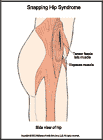
Snapping Hip Syndrome
What is snapping hip syndrome?
Snapping hip syndrome is a condition in which you feel a snap on the outside portion of your hip as you walk or run. It may happen only occasionally or it may happen all the time.
How does it occur?
Several groups of muscles cross the hip as they pass from the thigh bone to the pelvis. When you bring your knee forward during walking, you may have a feeling of snapping in the hip. The snapping usually occurs because of tightness in a muscle called the iliopsoas or tightness in a muscle called the tensor fascia lata.
What are the symptoms?
You feel snapping in your hip as you walk or run.
How is it diagnosed?
Your health care provider will examine your hip and thigh. He or she may be able to feel the muscle group that is snapping as the leg moves forward.
How is it treated?
Since this problem usually occurs because some muscles are too tight and some muscles are too loose, you will be given exercises to both strengthen and stretch your hip and thigh muscles. Your health care provider may prescribe an anti-inflammatory medication if this area is painful. If this area becomes inflamed, your provider may recommend that you put ice packs on the area for 20 to 30 minutes every 3 to 4 hours for 2 to 3 days or until the pain goes away.
When can I return to my sport or activity?
The goal of rehabilitation is to return you to your sport or activity as soon as is safely possible. If you return too soon you may worsen your injury, which could lead to permanent damage. Everyone recovers from injury at a different rate. Return to your sport or activity will be determined by how soon your hip recovers, not by how many days or weeks it has been since your injury occurred. In general, the longer you have symptoms before you start treatment, the longer it will take to get better.
You may safely return to your sport or activity when, starting from the top of the list and progressing to the end, each of the following is true:
- You have full range of motion in the affected hip compared to the unaffected hip.
- You have full strength of the affected hip compared to the unaffected hip.
- You can jog straight ahead without pain or limping.
- You can sprint straight ahead without pain or limping.
- You can do 45-degree cuts, first at half-speed, then at full-speed.
- You can do 20-yard figures-of-eight, first at half-speed, then at full-speed.
- You can do 90-degree cuts, first at half-speed, then at full-speed.
- You can do 10-yard figures-of-eight, first at half-speed, then at full-speed.
- You can jump on both legs without pain and you can jump on the affected leg without pain.
How can I prevent snapping hip syndrome?
Snapping hip syndrome may be prevented by stretching the muscles that cross the hip from the pelvis to the thigh bone.

